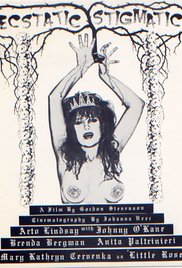 One of the more infamous examples of the “No Wave” film movement. One imdb user claimed ECSTATIC STIGMATIC was “the only film which led (him) to search online to see if the director had gone insane.” The director in question, Gordon Stevenson, did not go insane, as he unfortunately died of AIDS within a year of the film’s completion, while its star Mirielle Cervenka (the younger sister of X’s Exene Cervenka) was killed in a car accident while promoting it in LA.
One of the more infamous examples of the “No Wave” film movement. One imdb user claimed ECSTATIC STIGMATIC was “the only film which led (him) to search online to see if the director had gone insane.” The director in question, Gordon Stevenson, did not go insane, as he unfortunately died of AIDS within a year of the film’s completion, while its star Mirielle Cervenka (the younger sister of X’s Exene Cervenka) was killed in a car accident while promoting it in LA.
Is ECSTATIC STIGMATIC any good? No, but it’s not without a certain deranged fascination for receptive viewers. I think that after reading through the following you’ll know whether you’re one of those viewers or not!
Inspired by the book SHE WEARS A CROWN OF THORNS by Onesimus Alfred Boyer, about the “Stigmatized Ecstatic” Marie Rose Ferron (1902-1936), it begins with recitations of a couple case histories from Richard von Krafft-Ebing’s PSYCHOPATHIA SEXUALIS that are fleshed out by highly stylized dramatizations. From there we segue into the story of the aforementioned Rose, a young woman interred in a mental institution. She suffers from stigmata, i.e. wounds resembling those of the crucified Jesus Christ, on her hands, feet and mouth. This has made her a minor celebrity, and the object of a blood cult, but she suffers great pain and loss of appetite, coupled with frequent seizures.
It’s suggested the Rose is the victim of “Parental auto-suggestion,” which has apparently caused her to externalize her inner torment in the form of stigmata. Flashbacks show just how freaky her childhood was: her father was a deranged tattoo artist who favored bloody religious imagery (an example of which we see being carved into a guy’s back in lingering close-up) and her mother a performance artist who stripped for bored audiences while reciting stream-of-consciousness monologues. During one such performance the “child” Rose (actually the grown-up Rose acting like a child) was molested in her mother’s make-up lounge by a freak.
Back in the here-and-now the immobilized Rose is assailed by a spectral figure who apparently represents her conflicted psyche. Will she manage to put her demons behind her and engage with reality? Not even the filmmakers seem to know for sure!
The film is quite innovative in its use of narration, which is solemn and sarcastic by turns, and spoken—or, rather, shouted—in a voice that is clearly not that of the learned psychiatrist it purports to be. Furthermore, that narration sounds as if it was recoded in somebody’s living room with an analogue tape recorder.
The whole thing is hopelessly low budget in most respects, which was an essential component of the No Wave aesthetic. The 1920s setting clashes mightily with the late-1970s fashions and hairstyles sported by the cast, an effect that seems fully intentional. Likewise the comically threadbare décor, which never resembles anything other than the skuzzy NYC hovels in which it was filmed. Again, however, such non-slickness was integral to the No Wave vibe (for the ultimate example of which see the No Wave mainstay ROME 78, which attempts, or rather doesn’t, to recreate ancient Rome on the streets of NYC circa 1978).
The soundtrack, in the manner of quite a few No Wave flicks, seems designed to drive viewers mad, with wolf howls, discordant jazz music and other ephemera played at full volume throughout. This means that to get the desired effect the film, like those of its No Wave fellows, must be viewed in its intended big screen venue. How unfortunate, then, that as of 2017 the only available source for ECSTATIC STIGMATIC is a poor quality VHS dub!
Vital Statistics
ECSTATIC STIGMATIC
GSMC
Director: Gordon Stevenson
Cast: Mirielle Cervenka, Arto Lindsay
